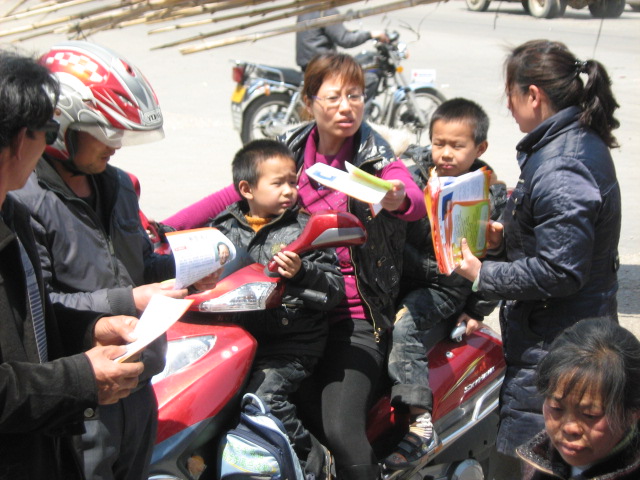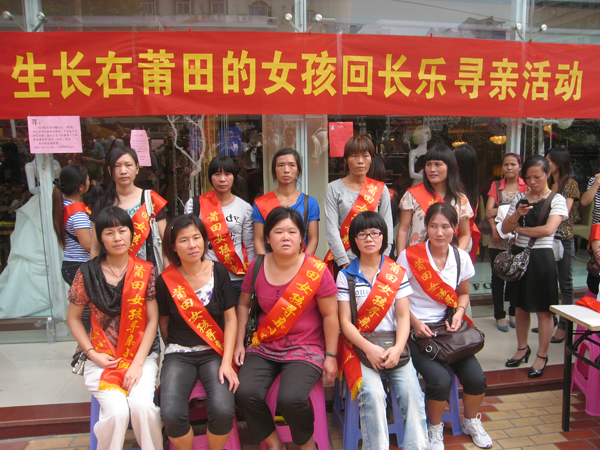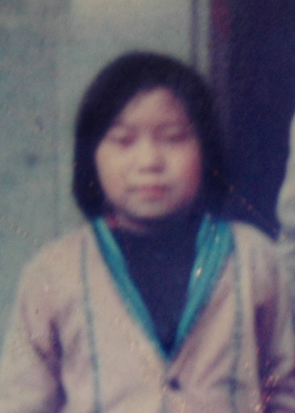Putian, China Child Bride Trafficking Report
Women’s Rights in China
by Jing Zhang
The written record of child brides in China began as early as the Three Kingdoms period. One of the great Yuan Dynasty tragedies, Dou’e Yuan, chronicled the tragic story of a girl who was sold into slavery. Ancient child bride practices originated mainly from gender discrimination, resulting in some poor families, unable to raise her daughters, selling young women to be raised and married to the sons of rich families. In addition, polygamy also contributed to the practice of child brides in traditional society.
With the development of modern culture, official governmental promotion of gender equality, and legally mandated monogamy, the practice of child brides has attracted wide condemnation. However, in the 21st century, this vice continues in China. Not only has it persisted or been revived in some villages and municipalities, but it has actually intensified. Furthermore, the pattern of child trafficking has changed dramatically from buyers and seller families completing transactions directly by negotiating agreements, to today’s organized trade in kidnapped girls, committed by rings of human traffickers who profit enormously. Among the areas where the phenomenon of child brides is the most severe is in “Putian” in Fujian Province, where wide-spread human trafficking has been noted.[i]
Major Center of Child Bride Trafficking
Putian is situated in the central coast of Fujian Province, population 306.97 million. The Putian area has a large number of trafficked women, many of whom lived the life of a child bride from a young age, and cannot find their loved ones in distant areas for various reasons. Some were sold when too young, and after years of helplessness, the memory of their original homes faded. From 2009 to 2011, during three separate campaigns, WRIC and associated organizations helped reunite three former child brides from Beigao of Putian with their loved ones in faraway Guizhou province. They had almost no memories of their hometowns, only vaguely recalling a few words of their original dialect. The three victims were transported on trains through circuitous routes from Guizhou to Fujian. WRIC volunteers with these scanty clues tried to match these memories to maps to find similar sounding towns and hamlets. Volunteers also turned to the media. Often after repeated efforts could volunteers reunite these trafficking victims with their biological parents.


Women’s Rights in China anti-trafficking campaign in Putian. Volunteers educating the public. Left is an image of the leaflets they are distributing.(Graphic by WRIC)
In October, 2010, hundreds of Putian women imitated the WRIC and spontaneously organized campaigns in Changle, Fujian to search for their families. These former child trafficking victims, who had become wives and mothers, continue to search for their families. 800 child brides registered on the website dedicated to Putian trafficking victims recently. They were all born from the 1970’s to the 1990’s and among the most determined and technology-savvy of the former victims.[ii]


Trafficking victim’s self-organized family reunion campaign. (Photos by WRIC)
The WRIC volunteer group started an education campaign on March 27th along the entire Putian coast. Volunteers received six requests for assistance from six trafficking victims who were abducted at young ages. After local television and print media coverage, within a short period of time, nearly 30 young women made contact with WRIC volunteers to say they had been stolen as children and sold as child brides. Everywhere our volunteers talked with local residents, the answers were the same. In Town B, the average thirty year-old grew up with seven or eight siblings, even up to a dozen or more. Of these “siblings”, more than a quarter were bought and “adopted”. Almost every household raised child brides. In the coastal fishing communities, the One-Child Policy was largely ineffective. The villagers were not deterred by government fines.
Hundreds of Thousands of Trafficked Child Brides
Zhenping Village, Donghai Town is 30 kilometers away from Putian proper. Of 900 households in this settlement with a population of 4,300, there were nearly a thousand trafficked child brides.[iii]A notorious case of a child bride being beaten to death occurred in 2003. The village was widely reported as a “Child Bride Village” in the media. According to a 2005 survey, the local primary school had 60 sixth grade students including 33 girls. 14 of them were child trafficking victims, accounting for 42.4% of the total number of girls. The fifth grade had 31 girls. 7 were trafficked, accounting for 22.6% of the total number of girl pupils. [iv]
The government has never conducted any investigation on the problem of trafficked child brides. Using only the most conservative methods would still give shockingly high numbers of child brides in the Putian region.
Conservative Estimate Using Town D, Putian as an Example
In the 1980’s and 1990’s, rural Putian families had seven to eight children on average. The number could be even higher. Over a quarter of the children were bought. For example, Xiao Guangyan was kidnapped from Guizhou and raised in a household of eleven siblings, including three child brides. Peng Qinglan, another trafficking victim, had eight “siblings”, including two trafficked girls. Two of Wong Qinghua’s six “siblings” were bought. Wong Qinqin had many “brothers”. She was the bought child bride. 8 children in these four families were trafficked girls bought to be raised as child brides. Five of them were eventually married to their “adopted brothers” inside the family.
In the 1980’s the average Beigao family raised eight children. To use a conservative estimate, if four of these children have married and formed families by now, then the single family in the 80’s would produce five families today. Even if we exclude the possibility that 30-year old generation buying any additional child brides, the fact that the older generation bought at least one child bride per family was certain. In other words, one of every five Putian household today is formed with at least one former child bride. There are 16,000 households in Beigao. This gives a number of 3200 child brides in Beigao Town alone.
To use Beigao, an average sized township, as a baseline, Licheng District, which includes six townships including Beigao would have 19,200 child brides. There are six administrative districts in Putian City. Extrapolating from Licheng’s numbers would give an estimate of Putian’s child bride population at 120,000. (This number does not include trafficked boys.) In other words, the most conservative estimate gives a number of 120,000 child brides trafficked to Putian in the 1980’s and 90’s.
Two mothers looking for daughters (left) and two trafficking victims looking for biological parents (right).
(Graphic by WRIC)
The Pessimistic Estimate Using Town D as an Example
In the 1980’s, during the most rampant period of its child trafficking trade, Beigao Town had a population of approximately 160,000[v]. If average household size was set at ten (eight children plus two parents), there would be 16,000 households. If an average family bought only one child bride, there would be 16,000 child brides in Beigao. Extrapolating with this number, Licheng District would have 96,000 child brides and the entire Putian region would have 576,000 child brides. In other words, the trafficked child bride population in Putian region amounts to nearly 600,000.
Beigao is not the township with the highest concentration of fishing villages in Putian. It is not among the towns where the child bride trafficking problem was the most severe. We use Beigao as an example for our calculation to get a more objective number. Coastal villages in Xiuyu District such as Litou and Pinghai had much higher proportions of trafficked women. In our campaigns in those areas, half the women we came into contact with had no memory of their childhood homes and origins, let alone their birth parents.
Based on the two estimates above, Putian’s child bride population ranges between 120,000 and 600,000. Even the lower estimate is shocking for a city the size of Putian. This number represents the suffering of 120,000 families and the sorrow of 120,000 girls and young women who lost their precious freedom.



25 years after her abduction, Xiao Guangyan (right) and Peng Qinglan finally found their biological parents.
(Graphic by WRIC)
Four Major Factors of Rampant Human Trafficking
First, the coastal fishing villages were the traditional home base of overseas Chinese. Economic conditions are generally far better than the Chinese interior. Families in this area could afford fines for “illegal” surplus population. Even government Family Planning Commission officials and their relatives purchase trafficked children with impunity. Local residents compete to have children. Marriage ages are generally rushed, with girls usually at 17 and boys at 19. If not enough children were born, the family would buy both sexes. The boys are used to augment labor, girls to raise as child brides. The fishermen do not worry about the registration problem, especially after the end of rationing of clothing and basic foodstuffs.
In 2010, Beigao residents had average income of 19,068 yuan[vi]compared to the national average of 5,919 yuan[vii]. Governmental population policy fines were relatively affordable for the coastal fishermen who enjoyed early prosperity. Even today, new families typically give birth to more than three children.
Second, the fishermen’s family serves as the basic economic unit. A fishing boat had to be served by the hard physical labor of at least five or six men, who were usually father and sons. If it was impossible to produce sufficient number of boys, local families did not hesitate to buy boys. The number of men in a family was taken as a sign of pride. As a result, for a long time men in these fishing villages found it difficult to find wives, especially since local women tended to marry outside the villages. Bride prices are also extraordinarily high, to be paid to the woman’s family. A purchase of a trafficked young girl, even with the cost of years of rearing, is still more economical.
Putian’s economic structure, in addition to the rather unique single family fishing households, also included the manufacture of genuine or fake name brand footwear and clothing. There exists a large scale demand for labor, which is common throughout the coastal areas of Fujian. Similarly, human trafficking has been prevalent in these areas. Additionally, the coastal region of Fujian became centers of illegal drug trafficking. Beigao was named a focus point of the government’s anti-drug trafficking campaign.[viii]The Taiwanese fishing industry also added more demand for cheap labor from the Mainland, absorbing large numbers of local young males, giving additional incentive to local families to buy boys. Correspondingly more girls were trafficked into the region to become child brides to make up the gender imbalance.Third, deep-rooted discrimination of girls and women persists. Many parents would not disclose to a boy they bought that he was “adopted”. But it was different for girls. To dispel their psychological reluctance to marry men who were reared as “brothers”, the family would easily disclose their origin as trafficked children. Local families almost uniformly inform them that they were from City B, another Fujian city.
The neighboring city of City B became an important transfer market of trafficked populations. Police had cracked a number of human trafficking rings that traded in City B. These criminal groups were usually organized by family. The kidnapping and transport of children was streamlined and comprehensive. Chongqing government reported on August 16, 2010 that it arrested, during a rescue operation in City B, 17 suspects, members of an extended family, who kidnapped 15 children whose ages ranged from 2 to 7.[ix]
Third, deep-rooted discrimination of girls and women persists. Many parents would not disclose to a boy they bought that he was “adopted”. But it was different for girls. To dispel their psychological reluctance to marry men who were reared as “brothers”, the family would easily disclose their origin as trafficked children. Local families almost uniformly inform them that they were from Changle, another Fujian city.
The neighboring city of Changle became an important transfer market of trafficked population. Police had cracked a number of human trafficking rings that traded in Changle. These criminal groups were usually organized by family. The kidnapping and transport of children were streamlined and comprehensive. Chongqing government reported on August 16, 2010 that it arrested, during a rescue operation in Changle, 17 suspects, members of an extended family, who kidnapped 15 children whose age ranged from 2 to 7.[x]
Fourth, the local government and police acquiesce and condone purchase of trafficking victims by local families. Authorities know that almost every household has a child bride, but never investigated the increase of unregistered population, sudden appearances of children in a family, because many of the purchasers were their friends and relatives. Neighbors and relations collaborate to keep their secrets. Similar situations exist in large areas of Fujian province. Protests to local authorities are unlikely to produce any result other than violent retaliation by human traffickers.
An official of the Putian Welfare Department, when talking about the case of the child bride who was beaten to death, that the government was aware of trafficked child brides in Pingyang village, but considered it outside of their jurisdiction. He said that if a girl was born outside of the legal quota, the Population Planning Bureau would be responsible. However, human trafficking was entirely the police’s concern. If the child brides are not registered with the government, the welfare departments had no methods to register them, since laws on adoption did not apply. The official considered that child brides in remote areas to be normal. He did not think reporters should have investigated this problem. “Would you help them find wives?”[xi]
Putian’s rapid economic rise in the last decades has progressed concurrently with the expanding child bride trafficking problem. As families witnessed the unhappy results of child bride unions, very recently the purchase of young girls solely for the purpose of child brides has abated somewhat from its formerly rampant level. However, nationally the problem has become more serious. Since 2005, northern provinces like Shaanxi, Shanxi, Henan and Shandong saw a sharp increase in missing girls. In Heilongjiang Province in May 200, nine girls went missing at the same time. Four were eventually rescued by the Heilongjiang police, but the rest remained missing. In October 2008 four students of the Commercial School in Jilin City went missing. Local police department would not take the case over a month later to manipulate crime statistics in the jurisdiction.[xii]
The number and price of trafficked girls have overtaken trafficked boys, as a result of the severe gender imbalance produced by the One Child Policy in poor rural areas. For the foreseeable future, trafficking in girls and young women would only increase due to the large and growing demand for brides in the countryside.
[i]Legal Daily, Apr. 13, 2011
[ii] http://www.cl163.com/xqr1.htm
[iii] http://www.geerga.com/node/179
[v]Guizhou governmental press, Haixia Dushibao, June 26, 2006
[vii]Chinese National Statistical Bureau
[viii]Haixia Dushibao, June 26, 2006
[ix] http://www.xbpf.gov.cn/platform/news_view.asp?newsid=5013
[x] http://www.xbpf.gov.cn/platform/news_view.asp?newsid=5013
[xi] http://www.xiancn.com/gb/news/2005-12/23/content_748098.htm
[xii]Urban Evening Paper, Nov. 5, 2008










Great article! We will be linking to this particularly great content on our site.
Keep up the good writing.